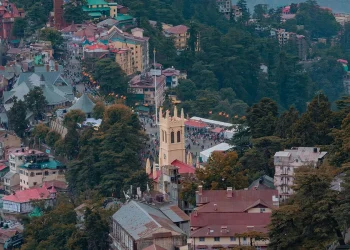Tourism in Himachal Pradesh has long been a point of pride, attracting visitors to the scenic landscapes of the region. However, for the Himachal Pradesh Tourism Development Corporation (HPTDC), it has turned into a costly burden. The corporation now faces pressure not only from rising losses but also from the Himachal Pradesh High Court, which is demanding answers and action.
Recently, during a hearing related to a petition filed by Jai Krishan Mehta (CWP No. 9681 of 2023), the Himachal Pradesh High Court voiced concerns about financial mismanagement within HPTDC. The court reviewed an affidavit submitted by the Managing Director of HPTDC, which unveiled alarming figures. As of August 31, 2024, the corporation owed Rs. 35.13 crore in unpaid dues to retired employees. This backlog is seen as a symptom of a deeper financial crisis within the organization.
Presided over by Justice Ajay Mohan Goel, the court instructed the Principal Secretary (Tourism) and the Managing Director of HPTDC to submit affidavits outlining remedial measures prior to the next hearing on October 3, 2024. Issuing a firm directive, the court ordered that separate affidavits should be filed by this date to ensure that something indeed is done to convert these white elephants (HPTDC run properties) into profit-earning units. This directive leaves little room for further delay, requiring concrete steps to address the growing financial troubles of HPTDC.
Decades of Losses and Missed Opportunities
HPTDC is not alone in its financial struggles. It is one of 12 loss-making public sector undertakings in the state. In 2022, the corporation reported losses exceeding Rs. 122 crore. A workforce of 1,800 employees remains tied to a system that has shown little promise of recovery. The failure to innovate and compete with private players has placed the corporation in a precarious situation. Currently, 35 out of 55 HPTDC properties continue to operate at a loss.

Tourists Turn to Private Options
Although Himachal Pradesh continues to attract a large number of tourists, many are avoiding properties run by HPTDC. Private hotels and restaurants, offering superior services and amenities, have captured a considerable share of the tourism market. HPTDC has struggled to maintain its facilities and provide competitive services, leaving many prime locations underused.
Also Read: Nine Must See Places In Himachal Pradesh
This scenario is concerning, as HPTDC oversees properties in some of the most scenic and popular areas of the region. Even with valuable real estate, the corporation has failed to turn these assets into lucrative ventures.
Surprising Losses at Popular Destinations
What makes the state of affairs more perplexing is that many of these loss-making units are located in the most frequented destinations of Himachal Pradesh. Hotels and restaurants in Kullu, Manali, Dalhousie, and Dharamsala have all reported losses despite these locations being popular with both domestic and international visitors.
Even in places like Kasauli, where the new Ros Common hotel is turning a profit, older units remain in the red. This discrepancy between profitable and loss-making properties within the same region points to deeper structural issues within the corporation.
Leasing and Partnerships: A Way Forward?
The court suggested that HPTDC consider leasing out its underperforming properties or forming partnerships with private entities, who could manage these ventures more efficiently and turn them into profit-generating assets.
The court has made it clear that, without decisive action, it may be left with no choice but to order the closure of some HPTDC properties. This strong warning highlights the urgent need for reforms to prevent the corporation from further draining public resources.
Government Eyes Private Players
Meanwhile, in an effort to revive HPTDC, the Congress government has crafted a strategy to bring in private players under an Operation and Maintenance (ONM) model. The government has categorized the 55 properties into three tiers—A, B, and C—based on their profitability and performance, and it intends to hand them over to private entities to maximize profits. While ownership of the properties would remain with the government, private firms would manage day-to-day operations.
Also Read: The 5 Best Offbeat Destinations To Visit In Himachal This Winter
This shift towards private sector involvement is viewed as a way to ensure that state assets are not left to wither away. The goal is to increase revenue and provide high-quality services without compromising on employment terms for existing HPTDC employees. However, uncertainty surrounds the fate of the 20 worst-performing properties, which are currently incurring losses, with the government yet to decide how to address their ongoing challenges.
A Few Bright Spots
Not all is bleak for HPTDC. Some of its properties, such as Hotel Holiday Home in Shimla and Palace Hotel in Chail, continue to perform well. Other profitable ventures include New Ros Common in Kasauli, Tea Bud in Palampur, and Bhagsu in Dharamsala. These successful units illustrate what HPTDC can achieve when properties are well-maintained and effectively promoted.

HPTDC is at a critical juncture. The ultimatum from the court, coupled with a government push for private sector involvement, could either mark the beginning of a turnaround or the end for many state-run properties. High Court scrutiny has brought these issues to the forefront, and now all attention is on how the government and HPTDC management will respond.
For the corporation, this moment is crucial. The lingering question remains whether the proposed reforms will suffice to revive the tourism gems of Himachal or if these once-cherished properties will vanish into obscurity.

Founded in 2016, The Traveller Trails is a print and digital magazine and a trusted source for current news, trends, analysis, opinions, interesting blogs, videos and exclusive interviews from every corner of the world.












